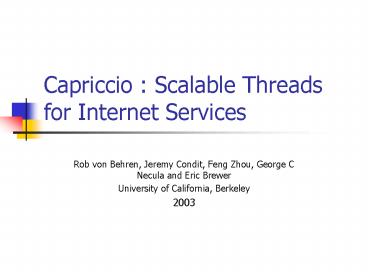Capriccio : Scalable Threads for Internet Services - PowerPoint PPT Presentation
1 / 20
Title:
Capriccio : Scalable Threads for Internet Services
Description:
Co-operative scheduling. Supports POSIX API. Provides: Scalability. Efficient stack ... Co-operative scheduling. Single CPU check Boolean lock/unlock flag ... – PowerPoint PPT presentation
Number of Views:55
Avg rating:3.0/5.0
Title: Capriccio : Scalable Threads for Internet Services
1
Capriccio Scalable Threads for Internet
Services
- Rob von Behren, Jeremy Condit, Feng Zhou, George
C Necula and Eric Brewer - University of California, Berkeley
- 2003
2
Intro
- Thread package
- At user level
- Co-operative scheduling
- Supports POSIX API
- Provides
- Scalability
- Efficient stack management
- Resource aware scheduling
3
Implementation
- Context switching
- Built on top of a co-routine library
- Fast context switch when threads voluntarily
yield - explicitly or by making blocking I/O call
4
Implementation
- I/O
- Intercepts blocking I/O calls at lib level
- Internally converted to
- epoll for socket, pipes
- AIO for disk I/O
- poll and kernel thread pool
5
Implementation
- Scheduler
- Lot like an event-driven application
- Alternates b/w running threads checking I/O
completion - Modular select b/w different schedulers at
runtime
6
Implementation
- Synchronization
- Co-operative scheduling
- Single CPU check Boolean lock/unlock flag
- Multi CPU spin locks or optimistic concurrency
control primitives
7
Linked Stack Management
- Stacks for threads bounded conservatively
- LinuxThreads 2MB of stack per thread (?)
- Affects scalability, waste of memory
- Better option allocate stack as needed dynamic
stack allocation/de-allocation
8
Stacks
overflow
http//capriccio.cs.berkeley.edu/publications.html
9
Compiler analysis and Linked Stacks
- Compiler analysis of program (CIL toolkit) to
generate call graph - Weighted directed call graph
- Each node represents a function, weighted with
max stack frame size - Edge A-gtB represents direct function call from
A to B
10
Call graph
- Paths represent sequence of stack frames
- Path length sum of weights of nodes
11
Usage
- Without recursive functions calculate longest
path static stack size - Might be too conservative
- So dynamic stacks using checkpoints
12
Checkpoints
- Piece of code inserted at call sites (edges)
- Checks if enough stack space left to reach next
checkpoint without stack overflow - If not, allocate stack chunk, move SP to new
stack chunk - Stack chunk de-allocated when function returns
13
Placing checkpoints
- Against at every call site, analyze graph
- Ensure bound on stack space between checkpoints
when creating them - Algorithm
- Break cycles
- Scan nodes upwards
- Break edges/call sites based on path limit
parameter (MaxPath)
14
Benefits Cost of stack linking
- Pre-allocation of large stacks unnecessary
reduces virtual memory pressure - Improved paging behavior because of stack chunk
reuse reduces app work set - Cost
- 73 slow-down in function calls alone but offset
by low number of calls (5)
15
Resource aware scheduling
- SEDA multiple event driven stages useful for
scheduling (queue size, stage part) - Capriccio pseudo stages separated by blocking
points - Blocking point places in program where threads
block
16
Blocking graph
- Created at runtime by studying block point
transitions - Node location of thread block in program
- Edge connects consecutive blocking points
- Edges annotated with weighted averages of
resource usage - Nodes weighted average of outgoing edge values
- Updated as threads traverse through nodes/edges
17
Usage
- Track each resource utilization level
- Determine dynamically if at limit
- Annotate each node with resources used on
outgoing edges - Predict impact on resources if threads from a
particular node is scheduled - Dynamically prioritize nodes (hence threads)
based on above
18
Cost
- Stack traces to locate blocking points
- Overhead - 8 of exec time for Apache with
Capriccio - 36 for Knot
- Aggregating resource utilization figures
- Overhead 0.1
19
Apache spin polling on fd, blocking I/O
callsHaboob/Capriccio poll() for n/w I/O
kernel thread pool for disk I/O
20
Discussion































